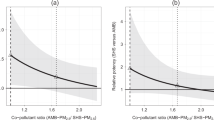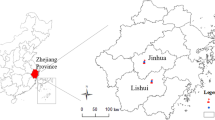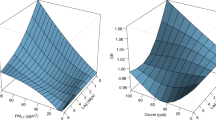Abstract
Previous time series or panel studies of asthmatics have reported respiratory health effects following short-term exposure to ozone (O3). We followed 186 children aged 10 years old in Athens and Thessaloniki, Greece for 5 weeks during the academic year 2013–2014 and recorded daily their respiratory symptoms, absenteeism and peak expiratory flow (PEF). We applied mixed models controlling for various possible confounders to investigate the daily associations between O3 exposure — derived from weekly personal and fixed school site measurements calibrated using daily values of the fixed monitoring site nearest to the child’s school location — and PEF, presence of any symptom, cough and stuffy nose, as well as absenteeism. We tested the robustness of our findings to varying modeling assumptions and confounders and investigated effect modification patterns by medication use, time spent outdoors and prevalence of asthma. A 10 μg/m3 increase in O3 personal exposure was associated with increased odds of any symptom (odds ratio (OR): 1.19, 95% confidence interval (CI): 0.98, 1.44), largely attributed to the increase in the odds of stuffy nose (OR: 1.23, 95% CI: 1.00, 1.51). PEF and absenteeism were not related to O3 exposure. Our results were robust to several sensitivity analyses. Effects were modified by medication use as presence of symptoms but also decreases in PEF were mainly reported among non-users, while our effect estimates were not driven by the asthmatic subgroup of children. Our findings indicate that short-term O3 exposure may be associated with respiratory symptoms extending previously reported results for asthmatics to the general population.
This is a preview of subscription content, access via your institution
Access options
Subscribe to this journal
Receive 6 print issues and online access
$259.00 per year
only $43.17 per issue
Buy this article
- Purchase on Springer Link
- Instant access to full article PDF
Prices may be subject to local taxes which are calculated during checkout
Similar content being viewed by others
References
World Health Organization Review of Evidence on Health Aspects of Air Pollution – REVIHAAP Project: Final Technical Report. WHO. 2013.
Pope CA, III, Dockery DW . Health effects of fine particulate air pollution: lines that connect. J Air Waste Manag Assoc 2006; 56: 709–742.
US Environmental Protection Agency 2010. Available at: www.epa.gov/air/criteria/.html. (accessed 15 December 2015).
Tager IB, Balmes J, Lurmann F, Ngo L, Alcorn S, Künzli N . Chronic exposure to ambient ozone and lung function in young adults. Epidemiology 2005; 16: 751–759.
Geyh AS, Xue J, Ozkaynak H, Spengler JD . The Harvard Southern California Chronic Ozone Exposure Study: assessing ozone exposure of grade-school-age children in two Southern California communities. Environ Health Perspect 2000; 108: 265–270.
Bell ML, Zanobetti A, Dominici F . Who is more affected by ozone pollution? A systematic review and meta-analysis. Am J Epidemiol 2014; 180: 15–28.
Bell ML, McDermott A, Zeger SL, Samet JM, Dominici F . Ozone and short-term mortality in 95 US urban communities, 1987–2000. JAMA 2004; 292: 2372–2378.
Bell ML, Dominici F, Samet JM . A meta-analysis of time-series studies of ozone and mortality with comparison to the National Morbidity, Mortality, and Air Pollution Study. Epidemiology 2005; 16: 436–445.
Levy JI, Chemerynski SM, Sarnat JA . Ozone exposure and mortality: an empiric Bayes metaregression analysis. Epidemiology 2005; 16: 458–468.
Ito K, De Leon SF, Lippmann M . Associations between ozone and daily mortality: analysis and meta-analysis. Epidemiology 2005; 16: 446–457.
Samoli E, Zanobetti A, Schwartz J, Atkinson R, LeTertre A, Schindler C et al. The temporal pattern of mortality responses to ambient ozone in the APHEA project. J Epidemiol Community Health 2009; 63: 960–966.
Peng RD, Samoli E, Pham L, Dominici F, Touloumi G, Ramsay T et al. Acute effects of ambient ozone on mortality in Europe and North America: results from the APHENA study. Air Qual Atmos Health 2013; 6: 445–453.
Moreno-Macías H, Dockery DW, Schwartz J, Gold DR, Laird NM, Sienra-Monge JJ et al. Ozone exposure, vitamin C intake, and genetic susceptibility of asthmatic children in Mexico City: a cohort study. Respir Res 2013; 14: 14.
Barraza-Villarreal A, Sunyer J, Hernandez-Cadena L, Escamilla-Nuñez MC, Sienra-Monge JJ, Ramírez-Aguilar M et al. Air pollution, airway inflammation, and lung function in a cohort study of Mexico City schoolchildren. Environ Health Perspect 2008; 116: 832–838.
Just J, Ségala C, Sahraoui F, Priol G, Grimfeld A, Neukirch F . Short-term health effects of particulate and photochemical air pollution in asthmatic children. Eur Respir J 2002; 20: 899–906.
Ross MA, Persky VW, Scheff PA, Chung J, Curtis L, Ramakrishnan V et al. Effect of ozone and aeroallergens on the respiratory health of asthmatics. Arch Environ Health 2002; 57: 568–578.
Kim CS, Alexis NE, Rappold AG, Kehrl H, Hazucha MJ, Lay JC et al. Lung function and inflammatory responses in healthy young adults exposed to 0.06 ppm ozone for 6.6 hours. Am J Respir Crit Care Med 2011; 183: 1215–1221.
Scarlett JF, Abbott KJ, Peacock JL, Strachan DP, Anderson HR . Acute effects of summer air pollution on respiratory function in primary school children in southern England. Thorax 1996; 51: 1109–1114.
Chen C, Arjomandi M, Tager IB, Holland N, Balmes JR . Effects of antioxidant enzyme polymorphisms on ozone-induced lung function changes. Eur Respir J 2007; 30: 677–683.
Kelly FJ . Dietary antioxidants and environmental stress. Proc Nutr Soc 2004; 63: 579–585.
Mudway IS, Kelly FJ . Ozone and the lung: a sensitive issue. Mol Aspects Med 2000; 21: 1–48.
Kelly FJ . Vitamins and respiratory disease: antioxidant micronutrients in pulmonary health and disease. Proc Nutr Soc 2005; 64: 510–526.
Que LG, Stiles JV, Sundy JS, Foster WM . Pulmonary function, bronchial reactivity, and epithelial permeability are response phenotypes to ozone and develop differentially in healthy humans. J Appl Physiol 1985; 111: 679–687.
Monn C . Exposure assessment of air pollutants: a review on spatial heterogeneity and indoor/outdoor/personal exposure to suspended particulate matter, nitrogen dioxide and ozone. Atmos Environ 2000; 35: 1–32.
McConnell R, Islam T, Shankardass K, Jerrett M, Lurmann F, Gilliland F et al. Childhood incident asthma and traffic-related air pollution at home and school. Environ Health Perspect 2010; 118: 1021–1026.
Li S, Williams G, Jalaludin B, Baker P . Panel studies of air pollution on children's lung function and respiratory symptoms: a literature review. J Asthma 2012; 49: 895–910.
Gerrity TR, Weaver RA, Bernsten J, House DE, O’Neil JJ . Extrathoracic and intrathoracic removal of O3 in tidal-breathing humans. J Appl Physiol 1988; 65: 393–400.
Frischer TM, Kuehr J, Pullwitt A, Meinert R, Forster J, Studnicka M et al. Ambient ozone causes upper airways inflammation in children. Am Rev Respir Dis 1993; 148: 961–964.
Karakatsani A, Kapitsimadis F, Pipikou M, Chalbot M-C, Kavouras IG, Orphanidou D et al. Ambient air pollution and respiratory effects in mail carriers. Environ Res 2010; 110: 278–285.
Acknowledgements
The work has been co-funded by the European Commission and the Greek government by the National Strategic Reference Framework 2007-2013 Contract Ref: RESPOZE-children/2248.
Author information
Authors and Affiliations
Corresponding author
Ethics declarations
Competing interests
The authors declare no conflict of interest.
Additional information
Supplementary Information accompanies the paper on the Journal of Exposure Science and Environmental Epidemiology website
Supplementary information
Rights and permissions
About this article
Cite this article
Samoli, E., Dimakopoulou, K., Evangelopoulos, D. et al. Is daily exposure to ozone associated with respiratory morbidity and lung function in a representative sample of schoolchildren? Results from a panel study in Greece. J Expo Sci Environ Epidemiol 27, 346–351 (2017). https://doi.org/10.1038/jes.2016.32
Received:
Accepted:
Published:
Issue Date:
DOI: https://doi.org/10.1038/jes.2016.32
Keywords
This article is cited by
-
Effects of air pollution on restricted activity days: systematic review and meta-analysis
Environmental Health (2023)
-
Quantifying the short-term effects of air pollution on health in the presence of exposure measurement error: a simulation study of multi-pollutant model results
Environmental Health (2021)



